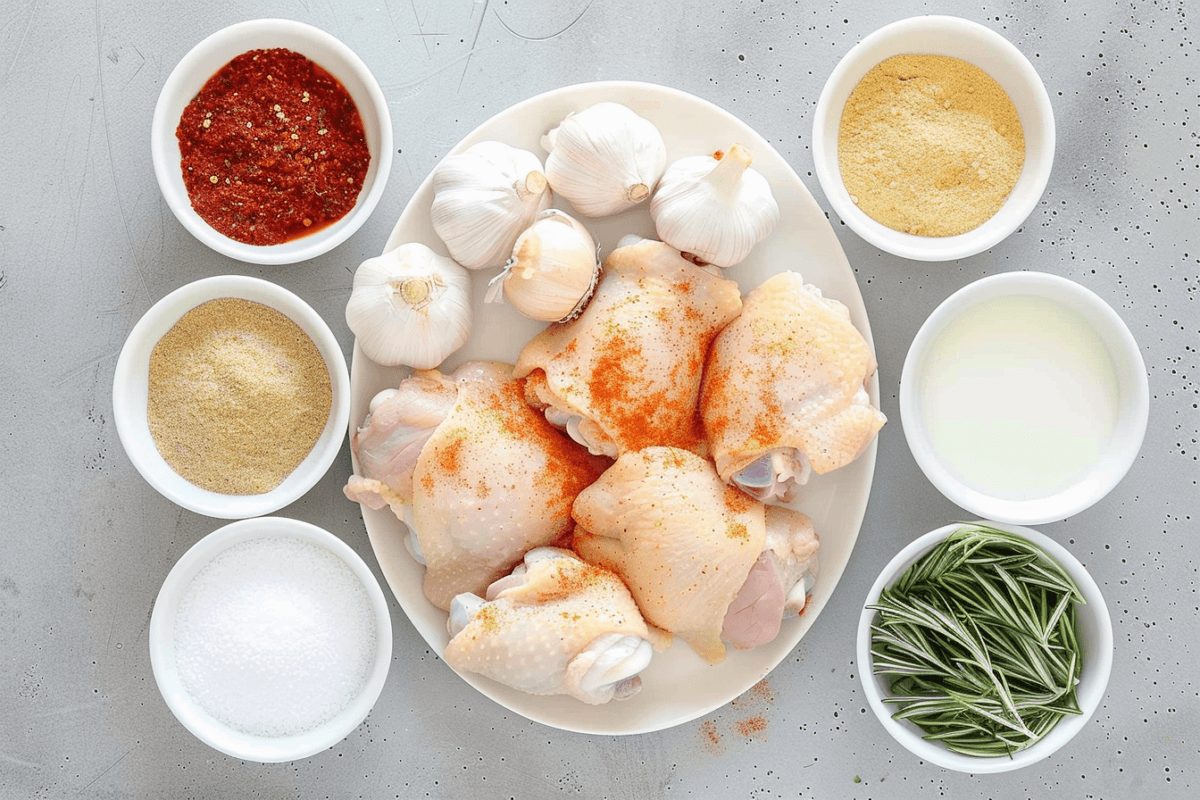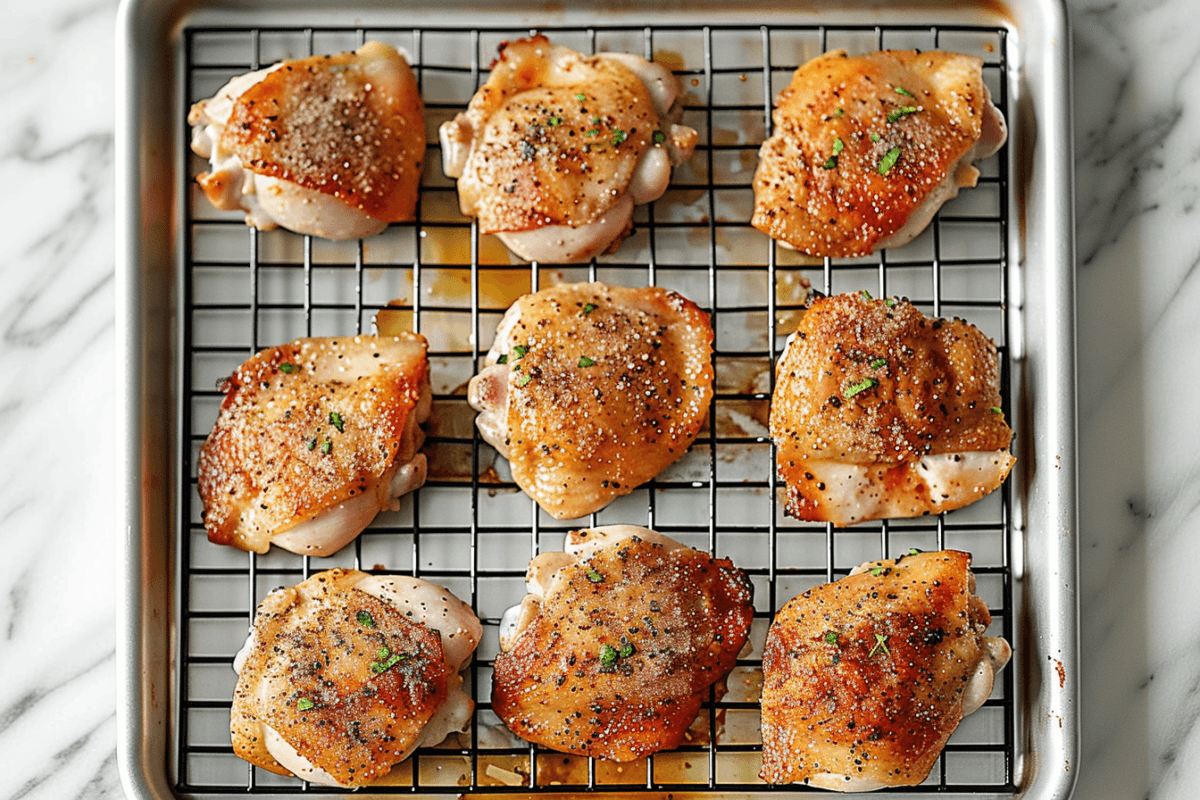Ever wondered whether to bake chicken thighs at 350°F or 400°F? The temperature you choose significantly impacts cooking time, texture, and flavor development.
This guide provides clear comparisons between both temperatures to help you achieve perfect chicken thighs every time. You’ll discover how each option affects juiciness, crispiness, and overall results, with practical advice for busy home cooks and culinary enthusiasts alike.
By the end, you’ll confidently select the right temperature for your specific needs, understand the science behind perfect chicken thighs, and master professional techniques for delicious results. We’ve included timing guides and preparation tips to ensure success regardless of your cooking experience.
Share your results in the comments below! Which temperature worked best for your chicken thighs?
Jump to:
The Science Behind Baking Temperatures
Temperature affects not only the cooking time but also how the chicken thighs retain moisture and develop flavor. Lower temperatures, such as 350°F, allow for slower cooking, helping the meat remain tender and juicy. On the other hand, higher temperatures like 400°F create a faster cooking process that results in crispy skin and caramelized flavors.
Why Temperature Matters
- Texture and Juiciness:
- Baking at 350°F is ideal for maintaining moisture, as the slower process minimizes the risk of overcooking.
- Baking at 400°F offers a crispier exterior, which is perfect if you’re aiming for golden-brown skin.
- Cooking Time:
- Chicken thighs baked at 350°F take approximately 45-50 minutes to cook thoroughly.
- At 400°F, the cooking time reduces to about 35-40 minutes, making it a quicker option for busy days.
- Flavor Development:
- Lower temperatures allow seasoning to infuse deeply into the meat.
- Higher temperatures enhance the Maillard reaction, creating bolder, roasted flavors.
Which Temperature is Safer?
Both temperatures are safe for cooking chicken thighs as long as they reach an internal temperature of 165°F. Using a meat thermometer ensures the chicken is fully cooked without being overdone.
How to Bake Chicken Thighs for Perfect Results
Typically, chicken thighs baked at 350°F take 45 to 50 minutes to cook. The cooking time may vary depending on factors like:
- Size of the Thighs: Larger, bone-in chicken thighs require more time.
- Oven Performance: Always preheat the oven and monitor its actual temperature using an oven thermometer.
Flavor and Texture Profile
Baking at 350°F allows the chicken thighs to remain moist because the lower temperature doesn’t dry out the meat. This method is ideal for dishes where tenderness is key, such as:
- Creamy chicken casseroles.
- One-pan dinners with vegetables like potatoes, carrots, and onions.
- Marinated chicken thighs, where the slow cooking helps the flavors seep deeply into the meat.

Skin Texture:
While the meat remains juicy, the skin at 350°F may not become as crispy unless broiled briefly at the end of cooking.
Bake Chicken Thighs at 350°F for Tender, Juicy Results
- Marinating for Flavor: Since the slower cooking allows the seasoning to penetrate the meat, marinating the thighs for at least 2 hours enhances the taste.
- Using a Covered Dish: Covering the dish with foil or a lid helps lock in moisture.
- Checking Internal Temperature: Always ensure the internal temperature reaches 165°F, measured at the thickest part of the thigh.
Pros of Baking at 350°F
- Tender and juicy meat.
- Ideal for recipes with a lot of liquid, such as sauces or broths.
- Less risk of overcooking for novice cooks.
Cons of Baking at 350°F
- Skin may not crisp up without additional steps.
- Takes longer to cook compared to higher temperatures.
How Long to Bake Chicken Thighs at 400°F
Chicken thighs baked at 400°F take approximately 35 to 40 minutes to cook. This faster cooking time makes it a great option for busy weeknights or when you’re preparing multiple components of a meal.
Factors affecting cooking time include:
- Bone-In vs. Boneless: Bone-in thighs take a bit longer than boneless cuts.
- Thickness: Thicker cuts of chicken require more time to cook through.
Flavor and Texture Profile
Many cooks believe the answer to “Is it better to bake chicken thighs at 350 or 400” depends on your preference for crispy, golden skin. This makes it an excellent choice for dishes like:
- Standalone chicken thighs with minimal seasoning, highlighting the roasted flavor.
- Meals where a crispy exterior adds a layer of texture, such as sheet-pan dinners with roasted veggies.
Skin Texture:
At 400°F, the skin crisps up naturally due to the higher heat, especially if the chicken thighs are brushed with oil or butter.
Best Practices for Baking at 400°F
- Preparation for Crispy Skin: Pat the chicken thighs dry with paper towels before seasoning to enhance crispiness.
- Season Generously: High temperatures intensify flavors, so using bold seasonings or dry rubs works well.
- Use a Wire Rack: Placing the chicken on a wire rack over a baking sheet ensures even airflow and allows excess fat to drip off, further crisping the skin.
Pros of Baking at 400°F
- Faster cooking time.
- Crispy, golden-brown skin without the need for broiling.
- Deep, roasted flavors that pair well with bold spices.
Cons of Baking at 400°F
- Slightly higher risk of overcooking if not closely monitored.
- May dry out if the thighs are too lean or not properly prepared.
Special Considerations
Baking at 400°F works particularly well for small to medium-sized thighs. Larger pieces may require a lower temperature to ensure even cooking without burning the exterior. Always use a meat thermometer to verify an internal temperature of 165°F.
How Long to Bake Chicken Thighs: 350°F vs. 400°F
- At 350°F: Chicken thighs typically take 45 to 50 minutes to cook. This slower pace is ideal if you’re multitasking or baking alongside other slow-cooking ingredients.
- At 400°F: The thighs cook faster, requiring about 35 to 40 minutes. This shorter cooking time makes it a convenient option for busy days.
- In the debate of “Is it better to bake chicken thighs at 350 or 400,” both options provide delicious results. Baking at 350°F is perfect for juicy, tender meat, while 400°F excels in creating crispy, caramelized skin.
If you’re looking for a zesty and flavorful twist, don’t miss our recipe for Lemon Pepper Chicken Thighs—perfect for any occasion!
Texture and Juiciness
- 350°F: Produces tender, juicy chicken with a more uniform texture throughout. Ideal for dishes where the meat needs to soak up liquid or sauce.
- 400°F: Creates a crisp, roasted exterior while still retaining moisture inside. It’s perfect for those who love crispy chicken skin.
Flavor Profile
- 350°F: Subtle, well-rounded flavors develop as the seasoning and natural juices permeate the meat.
- 400°F: Bold, roasted flavors emerge due to the Maillard reaction, which occurs more prominently at higher temperatures.
Best Uses for 350°F
- Recipes that include sauces or braising liquids.
- Cooking larger chicken thighs that require more even heat penetration.
- Preparing meals where tenderness and moisture are the priority.
Best Uses for 400°F
- Achieving crispy skin on bone-in or skin-on chicken thighs.
- Cooking leaner cuts or smaller pieces quickly and efficiently.
- Recipes that call for a roasted finish with caramelized edges.
Side-by-Side Summary
| Aspect | 350°F | 400°F |
|---|---|---|
| Cooking Time | 45–50 minutes | 35–40 minutes |
| Texture | Tender and juicy | Crispy skin, slightly firmer meat |
| Flavor | Subtle and infused | Bold, roasted, caramelized |
| Best For | Slow-cooked dishes, braises | Crisp, roasted chicken thighs |
| Risk | Less risk of overcooking | May dry out without monitoring |
Choosing the Right Temperature for Your Recipe
If you’re cooking a casserole or a dish with vegetables that require longer roasting, 350°F may be the better option. However, for standalone chicken thighs or dishes where crispy skin is key, 400°F is ideal.

Common Mistakes to Avoid
- Overcrowding the Pan:
Leave space between the thighs for even cooking and airflow. - Skipping Resting Time:
Let the chicken rest for 5 minutes after baking to allow juices to redistribute for a juicier bite. - Not Preheating the Oven:
An accurate, preheated oven is essential for consistent cooking results.
To ensure you get the most flavor out of your chicken thighs, check out our guide on how to maximize flavor in chicken thighs.
FAQs About Bake Chicken Thighs:
What does rubbing lemon on chicken do?
Lemon juice tenderizes the meat by breaking down proteins, adds bright citrus flavor, and helps neutralize any unwanted odors. For best results, let it sit for 10-15 minutes before cooking.
How do you get the most flavor out of chicken thighs?
Marinate for 2-4 hours with bold ingredients like garlic and spices. Season generously, cook at the right temperature for your desired result, and always let the meat rest for 5 minutes before serving.
How does Gordon Ramsay cook chicken thighs?
Ramsay seasons generously, sears skin-side down until crispy, adds garlic, lemon and butter for flavor, then finishes in a 375°F oven for 10-15 minutes until fully cooked.
Should you put lemon on chicken before or after cooking?
Both! Before cooking to tenderize and infuse subtle flavor, and after cooking for a fresh burst of acidity. For lemon pepper chicken, using lemon at both stages maximizes impact.
Why should you wash your chicken before cooking?
You shouldn’t. Food safety experts including the USDA advise against washing chicken as it can spread harmful bacteria to surfaces and utensils. Proper cooking to 165°F kills bacteria effectively.
Conclusion
The debate between baking chicken thighs at 350°F versus 400°F ultimately comes down to what you value most in your finished dish. For juicy, tender meat that falls off the bone, 350°F delivers exceptional results with its gentle, thorough cooking process. If you crave that irresistible golden-brown, crispy skin with slightly faster cooking times, 400°F is your ideal temperature.
Remember these key takeaways for chicken thigh perfection:
- Always cook to an internal temperature of 165°F regardless of oven setting
- Pat thighs dry before baking for better browning
- Allow 5 minutes of resting time after cooking
- Match your temperature to your desired outcome: 350°F for tenderness, 400°F for crispiness
Both methods produce delicious results when executed properly, giving you the flexibility to choose based on your schedule, recipe requirements, and personal preference.
Final Thoughts
The beauty of mastering chicken thigh preparation lies in its versatility. Once you understand how temperature affects your results, you’ll find yourself confidently experimenting with different seasonings, marinades, and cooking methods. Whether you’re preparing a quick weeknight dinner or an impressive weekend feast, properly baked chicken thighs offer the perfect balance of convenience, flavor, and satisfaction.
Your Turn to Try
Have you discovered your preferred temperature for baking chicken thighs? We’d love to hear about your experiences! Did you find that 350°F or 400°F worked better for your favorite recipes? Share your tips, modifications, or questions in the comments below.
What’s your go-to seasoning combination for baked chicken thighs? Would you try a different temperature next time based on what you’ve learned? Tell us below!

